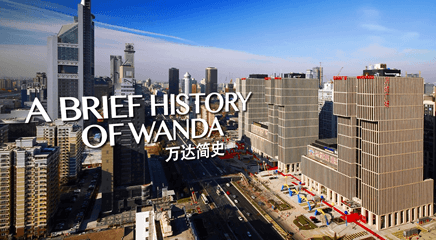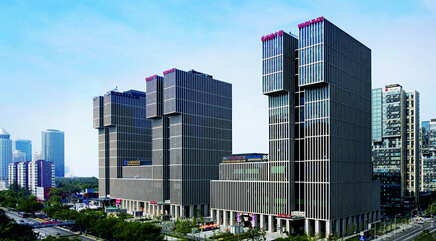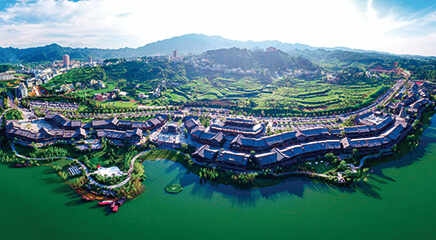Chairman Wang Jianlin Talks about City Value at “The Fourth Bund Global Financial Summit”
19.11.2016 “The Fourth Bund Global Financial Summit” was held in Shanghai on November 19, 2016. In attendance and speaking was Chairman Wang Jianlin of Wanda Group.
“The Fourth Bund Global Financial Summit” was held in Shanghai on November 19, 2016. In attendance and speaking was Chairman Wang Jianlin of Wanda Group.
Mr. Wang spoke of the three viewpoints he holds regarding whether a city is of value. He believes that the core value of a city is a booming business economy, but that good air is the core element of a city’s value. He asserted, “Decision-makers should not necessarily simply assume that building more subways and office buildings or making more financial centers will bring value to a city. Once there is a net outflow in population, the city’s prosperity begins to decline.”
Below is a record of the speech—
The Value of A City
Wang Jianlin
(November 19, 2016)
Dear Chairman Guo and distinguished guests:
Firstly, cities rise with the market.
How did the city come about? The origin of the city is debatable. There is an area of economics studies dedicated to urban areas. I believe the city originates from the rise of the market. Expansion of cities only occurs when there is a market and commercial prosperity. Take Yangzhou or Shanghai for instance. The Yangzhou of the Ming and Qing dynasties was made into a grand city because the sea and salt trade lured many merchants there for business. At its most prosperous time, Yangzhou’s trade accounted for one fifth of that of the entire nation, at which time there basically was no Shanghai. Later, due to the rise of shipping, everyone thought that sending freight to Shanghai was more convenient, so business and trading rose, creating prosperity in Shanghai. Actually, all the cities in the world were formed in this way. Which cities have been called the “World City” or the world’s central city? Certainly this wasn’t brought about by business prosperity, but it can’t be because of something else. This is my first point: the prosperity of business determines the value of a city.
Secondly, the core value of a city is a booming business economy.
1. Now people say that if a location is good, it is of value. What does this mean? Saying that a place is a “prime location” or a “gold mine” basically means that the land is in a core business district, so the location is good and price of land is high. Of course residential areas with good environments can also be very expensive, but they would not be called “gold mines” or “core areas”. Shanghai’s “gold mines” are also centers: Huaihai Road and Nanjing Road, with three sub-centers: Xujiahui, Wujiaochang, etc. These so-called centers and sub-centers are seen in the aggregate business and level of prosperity. Therefore, the city must realize that its core value lies in the creation and maintenance of a booming business economy. Of course there is another index, which is the aggregation of population. Maintained business prosperity leads to a sustained population flow, both in and out. I just spoke of a “global city”, which is real. Take for instance places like Paris, Hong Kong, Tokyo, Beijing and Shanghai, which all are [global cities]. The core value of a city is its commercial location.
2. Urban sprawl is also determined by the value of business. A large city can produce a sprawl effect, driving the development of surrounding areas. The entire Yangtze River Delta was driven by Shanghai. Because of business prosperity, [development] sprawled out along the entire Yangtze River Delta. There are about 15 or 16 cities with the ability to create sprawl, and this ability to sprawl is determined by the city’s business activities and not by the city’s GDP or revenue. Whether or not a city has the ability to sprawl is mainly determined by business activity. For instance, let’s talk about our two nearby examples; first let’s say that Jiangsu has a central city. If we talk about GDP, it is certainly Suzhou. But then why do we say that the central city in Jiangsu is Nanjing instead of Suzhou? I want to clear up these problems, as it is conducive to our decision-makers and entrepreneurs, who together can determine how to create and maintain a city’s prosperity. In the words of the General Secretary, we cannot only discuss GDP. The prosperity of cities and regions is a topic that should be well researched.
Thirdly, how can we maintain the value of a city?
Cities are of value, and its core is the value of business. How can we cause cities to maintain their value and avoid elimination? In fact, throughout history, few cities have survived centuries, maintained prosperity for thousands of years, or maintained a central position. In the past, in Central and Eastern Europe, ancient Rome was very powerful. Historically, there have been many very powerful central cities; the Yangzhou of several hundred years ago was much more powerful than Shanghai. But there is always a transfer, and what’s the reason for this? It is because the value of the city center is transferred. I say, purely from a business point of view that:
1. Businesses should be arranged reasonably. To create business value there must first be a reasonable plan. This is not to say that more is better; there is a balancing point. There must be a reasonable plan, not only a business center containing office buildings, but also having other service business-type facilities with a reasonable point. Two points are at the core of ancient Chinese philosophy and Confucian philosophy. Vertical strokes emphasize the golden mean and are even handed, and horizontal strokes emphasize balance. I’ll give you an example. For instance, Shenyang has one Qingnian Road with hundreds of office buildings and over 30 shopping centers. The result is that the street is now very bleak, and there is no prosperity. Thus, it is not more that makes it better, but rather having a reasonable arrangement. It should also be based on modern traffic and distributed accordingly.
2. In creating an attractive environment, the city’s business value is in businesses, office buildings, finances, exchange, trade squares, etc. However, you see that buildings and lots along rivers, lakes and green spaces are more valuable. It’s just like the BFC created by Guo Guangchang. Why this place? It’s next to the Huangpu River, and Shanghai’s most valuable property is that from which you can see the Huangpu River. Centers close to green spaces are also valuable, which means that the modern city’s business value is based not only on layout, but people also wish to have a more attractive environment within the city. Of course, there is also ease of traffic flow. This is to say that creating an attractive environment is also an important aspect in maintaining a city’s business value.
3. Good air is a core element of a city’s value. In the past, this was swept under the rug and ignored, but in recent years it has become an important factor in the value of a city. Now this is some burden; the two core cities of Beijing and Shanghai have terrible air. This problem should not be underestimated, as there will be a gradual decrease in the cities’ business value because of the poor air quality. If this continues, outstanding talents and companies will leave. Good companies will move. Scientific researchers, finance institutions and trading companies may also leave.
So, why am I speaking about the value of a city in present-day China? I hope that the city’s operators, especially the core decision-makers, will make it a main point in their governance to emphasize good air as a way to maintain cities’ core value and really resolve






